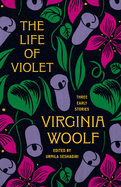
Every literary scholar dreams of unearthing some long-hidden manuscript or offering a groundbreaking perspective on a well-established author. With The Life of Violet, a trio of early works by Virginia Woolf, Urmila Seshagiri has done both, and the result is a work of profound scholarship and modern entertainment. Seshagiri's preface starts with an exclamation and two questions: "Reader! Can Virginia Woolf make us burst out laughing? And does anything remain to be said about her career?" The answer is a resounding yes. Besides the charm and wit of the stories themselves, Seshagiri's account of her discovery of the manuscript is fascinating, making this a volume attractive to even the most casual of literary historians.
While these early stories are distinctly Woolf, they offer a lighter entry point to what Sheshagiri calls "Woolf's career-spanning conviction that to reinvent literary form is to reconceive women's lives." Inspired by Woolf's intimate friend Violet Dickinson, the tales feature the fictional Violet, an exceptionally tall and terribly clever woman who has, as she sees it, only five good qualities, "and that's not enough to make a woman of." In the final story, the narrator unexpectedly pivots to an imagined folktale set in a Japanese village that is visited by two "Sacred Princesses" who defeat a sea monster with umbrellas, a seeming incongruity that works like magic. With a thoughtful afterword, explanatory notes, and a detailed list of Woolf's revisions, this book will be a boon to students and scholars, but readers of all stripes will appreciate this delightful and curious title. --Sara Beth West, freelance reviewer and librarian

